*New birds we’ve seen on our 2010 trip so far: white-wing dove
*National Parks/Monuments visited on 2010 trip so far: 1
*State Parks visited on 2010 trip so far: 1
So did you know that in TX the speed limit on I-10 is 80mph?! We didn't go anywhere near that fast in the motorhome…definitely not fuel efficient!
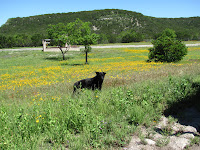
After spending the night at the Ft. Stockton Wal-Mart, it was on to Davis Mountains State Park in Ft. Davis, TX. As we travel along, we make periodic stops to stretch our legs, use the facilities, maybe eat something, and so on. On one such stop this trip, Mikey didn’t seem to want to get back in right away. Russ had removed his leash at the bottom of the stairs, but instead of going inside, he turned around and started wandering out into the flowers! Since he can’t hear much anymore, you can’t call him back but clapping loudly gets his attention. He’s such a silly boy!
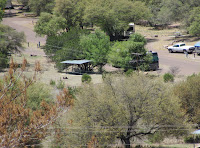
Our campsite at Davis Mountains State Park (www.tpwd.state.tx.us/spdest/findadest/parks/davis_mountains) was quite nice, a long pull-thru with full hook-ups situated at the bottom of the mountain. A few steps from the RV was our own covered picnic table, grill, and large grassy area. Within the park is the Skyline Drive that runs from th e camping area up the mountain using switchbacks to the boundary of Ft. Davis National Historic Site (though you can’t drive this way to get there), and I took a picture of our rig from up there (zoomed in, of course). The views of the park and surrounding area are spectacular from here (you can even see part of the observatory in the distance in the upper right of the photo at right). Warning signs are posted in the park to beware of bears, mountain lions, and javelinas (hav
e camping area up the mountain using switchbacks to the boundary of Ft. Davis National Historic Site (though you can’t drive this way to get there), and I took a picture of our rig from up there (zoomed in, of course). The views of the park and surrounding area are spectacular from here (you can even see part of the observatory in the distance in the upper right of the photo at right). Warning signs are posted in the park to beware of bears, mountain lions, and javelinas (hav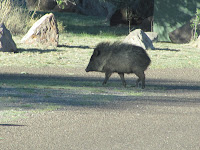 -uh-LEE-nas), and though we saw none of the first two, we did see our first javelina (sort of a wild pig) and several mule deer not far from our rig. Only down side to the park was that we had no internet or cell phone service at our site but driving 4 miles down the road each of the 3 days while we were there solved that problem.
-uh-LEE-nas), and though we saw none of the first two, we did see our first javelina (sort of a wild pig) and several mule deer not far from our rig. Only down side to the park was that we had no internet or cell phone service at our site but driving 4 miles down the road each of the 3 days while we were there solved that problem.
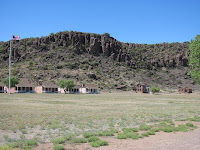 Our main reason for going to Davis Mountains State Park was to visit the McDonald Observatory, but we got an added bonus of nearby Fort Davis National Historic Site (http://www.nps.gov/foda). Named for then Secretary of War, Jefferson Davis, this is the best preserved fort we have seen in our travels. Most have only the brick foundations of the bu
Our main reason for going to Davis Mountains State Park was to visit the McDonald Observatory, but we got an added bonus of nearby Fort Davis National Historic Site (http://www.nps.gov/foda). Named for then Secretary of War, Jefferson Davis, this is the best preserved fort we have seen in our travels. Most have only the brick foundations of the bu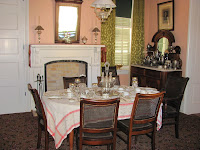 ildings, but here several of the buildings are still intact, having survived since shortly after the Civil War, and a few have been furnished as they would have been back then.
ildings, but here several of the buildings are still intact, having survived since shortly after the Civil War, and a few have been furnished as they would have been back then.
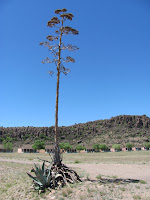 We stopped by the fort after we got settled at the campground so we could get our Passport book stamped and get the lay of the land. Near the entrance to the site are 3 agave plants, something we had not seen before. We learned that the agave blooms only once in its lifetime and then dies, and these had recently bloomed.
We stopped by the fort after we got settled at the campground so we could get our Passport book stamped and get the lay of the land. Near the entrance to the site are 3 agave plants, something we had not seen before. We learned that the agave blooms only once in its lifetime and then dies, and these had recently bloomed.
After spending the night at the Ft. Stockton Wal-Mart, it was on to Davis Mountains State Park in Ft. Davis, TX. As we travel along, we make periodic stops to stretch our legs, use the facilities, maybe eat something, and so on. On one such stop this trip, Mikey didn’t seem to want to get back in right away. Russ had removed his leash at the bottom of the stairs, but instead of going inside, he turned around and started wandering out into the flowers! Since he can’t hear much anymore, you can’t call him back but clapping loudly gets his attention. He’s such a silly boy!
Our campsite at Davis Mountains State Park (www.tpwd.state.tx.us/spdest/findadest/parks/davis_mountains) was quite nice, a long pull-thru with full hook-ups situated at the bottom of the mountain. A few steps from the RV was our own covered picnic table, grill, and large grassy area. Within the park is the Skyline Drive that runs from th
We returned on Wed. and decided to complete the Jr. Ranger program, such a great way to learn about the place you’re visiting. It just so happened that because of a school group, two of the National Park volunteers were in period costume. 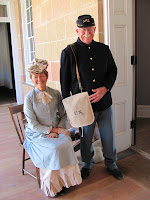 Mike Sloan was stationed in the Enlisted Men’s Barracks dressed in full uniform, and ready to answer any questions. We were surprised that the temperature inside this building was about 20 degrees cooler than outside which he told us was because of the thick adobe walls. As we talked with Mike, we discovered that he too was from St. Louis….small world! His wife, Jan, was in the Commanding Officer’s Quarters portraying Mrs. Grierson
Mike Sloan was stationed in the Enlisted Men’s Barracks dressed in full uniform, and ready to answer any questions. We were surprised that the temperature inside this building was about 20 degrees cooler than outside which he told us was because of the thick adobe walls. As we talked with Mike, we discovered that he too was from St. Louis….small world! His wife, Jan, was in the Commanding Officer’s Quarters portraying Mrs. Grierson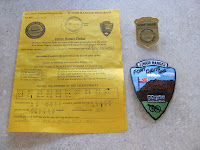 , whose husband had been the Commander at the fort in 1882. What a pleasure to meet such great people so full of knowledge!
, whose husband had been the Commander at the fort in 1882. What a pleasure to meet such great people so full of knowledge!
Tues. was our planned trip to McDonald Observatory (http://mcd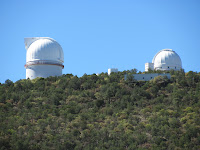 onaldobservatory.org/) which was built in the 1930s and is located up in the mountains 16 miles northwest of the park. Three nights a week a Star Party is held which gives you views of the night sky through telescopes, and we definitely wanted to participate so purchased the all day pass for $20 each. The pass included the dayt
onaldobservatory.org/) which was built in the 1930s and is located up in the mountains 16 miles northwest of the park. Three nights a week a Star Party is held which gives you views of the night sky through telescopes, and we definitely wanted to participate so purchased the all day pass for $20 each. The pass included the dayt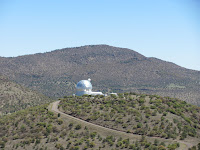 ime tour, the Twilight Program, and the Star Party. We arrived when they opened at 10am, toured the visitor’s center, watched a video, attended the Solar Viewing program in their multimedia theater (which shows you sun spots and flares as their happening live on the Sun), and then a 90-min. guided tour of two of their largest telescopes. The Harlan J. Smith Telescope, built in the mid-60s, h
ime tour, the Twilight Program, and the Star Party. We arrived when they opened at 10am, toured the visitor’s center, watched a video, attended the Solar Viewing program in their multimedia theater (which shows you sun spots and flares as their happening live on the Sun), and then a 90-min. guided tour of two of their largest telescopes. The Harlan J. Smith Telescope, built in the mid-60s, h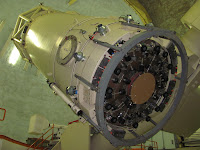 as a 107-inch mirror, and their newest, the Hobby-Eberly Telescope, has a 433-inch mirror (which is actually made up of 91 smaller mirrors combined to make one big mirror.) Since they are only used at night, we didn’t get any views through them but did learn how they operate (so much is handled now by computers). These telescopes are located at the top of Mt. Locke, the highest point on Te
as a 107-inch mirror, and their newest, the Hobby-Eberly Telescope, has a 433-inch mirror (which is actually made up of 91 smaller mirrors combined to make one big mirror.) Since they are only used at night, we didn’t get any views through them but did learn how they operate (so much is handled now by computers). These telescopes are located at the top of Mt. Locke, the highest point on Te xas highways at 6,791 feet. The entire program was fascinating, but probably the most memorable thing from this daytime tour was when our guide/shuttle bus driver, Joe, tried to back down the mountain road. Some construction trucks were blocking his way out, and he couldn’t figure out anyway to turn around (though there was one spot where he could have). He decided he would have to back down
xas highways at 6,791 feet. The entire program was fascinating, but probably the most memorable thing from this daytime tour was when our guide/shuttle bus driver, Joe, tried to back down the mountain road. Some construction trucks were blocking his way out, and he couldn’t figure out anyway to turn around (though there was one spot where he could have). He decided he would have to back down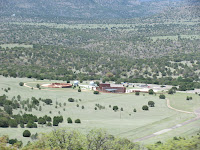 the hill till he got to the lower parking lot and assured everyone on board that he could see out his side mirrors just fine. This was a small shuttle but obviously he couldn’t see because he nearly ran off the road into the small retaining wall several times! People would tell him to turn the steering wheel to the left, and he’d keep turning it to the right while looking in his side mirror. Russ finally took charge, directing him from the back of the bus, and we finally got down the hill without going over the edge. Joe’s one of those geniuses who can tell you more than everything you want to know about telescopes and the universe but has no common sense. LOL
the hill till he got to the lower parking lot and assured everyone on board that he could see out his side mirrors just fine. This was a small shuttle but obviously he couldn’t see because he nearly ran off the road into the small retaining wall several times! People would tell him to turn the steering wheel to the left, and he’d keep turning it to the right while looking in his side mirror. Russ finally took charge, directing him from the back of the bus, and we finally got down the hill without going over the edge. Joe’s one of those geniuses who can tell you more than everything you want to know about telescopes and the universe but has no common sense. LOL
After a half hour break, it was time for the Star Party which once again began in the outdoor amphitheater. Our guide started with a tour of the constellations, using a laser pointer aimed at the night sky. It was a beautiful, clear night, and we were amazed at the number of stars we could see. Now it was time for viewing through the telescopes (not the huge ones we visited earlier in the day but five smaller ones set up around the visitor’s center). What did we see? We saw an open star cluster known as M35 located in the constellation Gemini that is comprised of several hundred “new” stars, meaning they are only about 150 million years old, and we saw an old star cluster that has about 350,000 stars and are a couple billion years old! We saw the spiral Whirlpool Galaxy, and the Sombrero Galaxy, which is 37 million light years away. Keep in mind these were all discovered back in the 1700s! But the coolest and most awesome thing we saw was the planet Saturn…absolutely amazing! It was clear, sharp, bright white, and we could clearly see its rings. We got back in line for another view, and it’s a sight we will not soon forget.

2 comments:
Susan, sounds like you guys are having a great time! Miss seeing you.
Ila
Love your BLOG! I want to be with you. Beautiful! Linda
Post a Comment